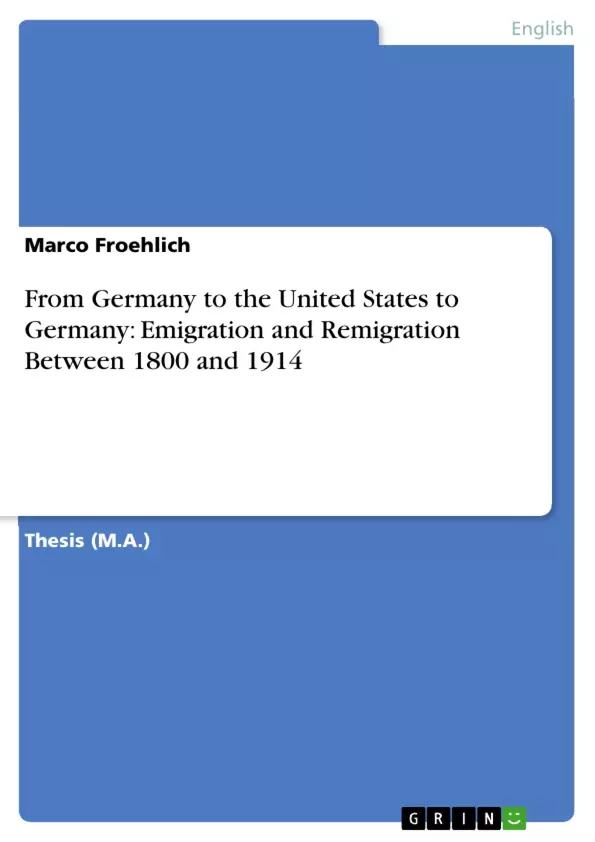Gegenstand dieser Magisterarbeit ist die deutsche Auswanderung in die Vereinigten Staaten von Amerika im Zeitraum von 1800 bis 1914. Eine Besonderheit stellt dabei sicherlich die Berücksichtigung der Rückwanderung nach Deutschland dar. Anders als in den meisten Werken zum Thema Auswanderung wird hier auf die Auswirkung der Erfahrungen, welche im Zielland gemacht wurden, im Hinblick auf die mögliche Entscheidung zur Rückkehr in die Heimat eingegangen.
In der heutigen medialen Berichterstattung wird ein teilweise zu einseitiges, in jedem Falle aber ein zu romantisierendes Bild der Auswanderung als Abenteuer vermittelt. Der Prozess der Migration galt jedoch seit jeher nicht nur als Hoffnungsträger für ökonomisch, sozial, politisch oder religiös Benachteiligte und Unterdrückte. Für viele war und ist Auswanderung der letzte, quasi unausweichliche Ausweg aus einer inakzeptablen Existenz im Heimatland.
Dass die transkontinentale Wanderung, speziell während der Ära der Massenwanderung im 19. Jahrhundert, mit zahlreichen Gefahren, Entbehrungen und Strapazen verbunden war, wird gern vergessen zu erwähnen. Diese Arbeit soll Aufschluss über die Schicksale von Auswanderern und den Akt dieser Migration geben, wobei der Schwerpunkt auf der Betrachtung der negativen Erfahrungen liegt.
Table of Contents
- Introduction
- German Immigration Prior to the 19th Century
- The First Germans in the New World
- War in the New World
- The American Revolution
- The Turn of the Century
- The Era of Mass Migration
- Motives and Circumstances - The Push & Pull Factors
- The Early 19th Century - A Period of Grievances
- The Refugees of 1848
- The Transportation of 'Social Flotsam'
- Attractors from Abroad
- Evading Military Service and Criminal Prosecution
- Emigration Between the Civil War and World War I
- A Review of the Push and Pull Factors
- The Journey to the New World
- The Departure
- The Voyage
- The Arrival
- Emigration/Immigration Legislation
- Emigration Restrictions in Germany
- Immigration Restrictions in the United States
- Summing up Both Legislations
- Germans in the New World - Bound to Remigrate?
- Images of a Paradise - Promises Hard to Keep
- The Reality - Experiences of German Emigrants
- Economic Disappointment
- Intended Remigration
- Family Reasons
- Deutschtümlichkeit - A Lack of Integration?
- Summarizing the Decision to Return
- The Scale of Remigration
- The Return to Germany
Objectives and Key Themes
This thesis examines the journey of German emigrants to the United States between 1800 and 1914, focusing not only on the reasons for emigration but also on the experiences of remigration back to Germany. It aims to highlight the challenges and obstacles associated with this transcontinental migration, both on a national and individual level.
- The push and pull factors motivating German emigration to the United States.
- The challenges and realities faced by German emigrants in the New World, including economic hardship and cultural integration.
- The motivations and circumstances behind remigration, including economic disappointment, family reasons, and the desire to return to a familiar culture.
- The difficulties and complexities of transcontinental migration, particularly in the context of the 19th century.
- The legacy of German emigration and remigration on both German and American societies.
Chapter Summaries
The first chapter provides a comprehensive introduction to the subject of German emigration to the United States, highlighting the contemporary interest in the "American Dream" and the importance of understanding remigration as a significant aspect of the migration experience. Chapter two explores the early history of German immigration to the United States, tracing its development from the first settlers to the turn of the 19th century. Chapter three delves into the era of mass migration, examining the various motives and circumstances that drove Germans to leave their homeland, including economic hardship, political upheaval, and social discrimination. Chapter four investigates the challenges and realities of the journey to the New World, including the departure process, the voyage across the Atlantic, and the arrival experience. The chapter also explores the evolving immigration and emigration legislation that shaped migration patterns in both Germany and the United States. Chapter five focuses on the experiences of German emigrants in the New World, exploring the complexities of adaptation, integration, and the factors that influenced their decision to remigrate.
Keywords
This work focuses on German emigration and remigration to and from the United States between 1800 and 1914. Key concepts include push and pull factors, economic hardship, cultural integration, acculturation, economic disappointment, family reasons, transcontinental migration, and the challenges of adapting to new environments.
- Citation du texte
- M.A. Marco Froehlich (Auteur), 2007, From Germany to the United States to Germany: Emigration and Remigration Between 1800 and 1914, Munich, GRIN Verlag, https://www.grin.com/document/88228



